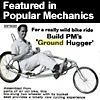|
|
|
|||||||||||||||||||
|
|
Featured First in
Popular Mechanics Magazine, April 1969
|
![]() Printed Plans - $39
Printed Plans - $39
![]() 2D CAD (dxf) & 3D Model (Rhino) on
CD-ROM - $35
2D CAD (dxf) & 3D Model (Rhino) on
CD-ROM - $35
![]() Both Printed and CAD - $50
(See NOTICE below in left margin)
Both Printed and CAD - $50
(See NOTICE below in left margin)
![]()
Order
Ground Hugger
Plans
(order a second item to get a discount & free shipping)
|
Safety in the event of a spill, and virtually zero stress on arms, hands, and low backs are other advantages. The attribute that receives the most accolades from new riders, however, is also the most difficult to justify in practical terms. The sheer thrill of gliding along at 30 mph just inches above the ground puts Ground Hugger in a class of its own. It's a sensation that has to be experienced in order to be fully appreciated. Riding a recumbent is an entirely different experience. One's sense of balance has to be reoriented to the new seating position and close proximity to the bicycle's reaction point. Because the ground is a bicycle's reaction point, the conventional riding position high above the ground translates into greater lateral distances between opposing lean angles, which means slower reaction times. A recumbent reacts more quickly because of the rider's low center of gravity and close proximity to the ground. New riders initially sense this quick reaction time as instability. But it's a matter of retraining one's sense of balance - about 15 minutes, depending on the person. Early versions of Ground Hugger were equipped with the Sturmey-Archer 3-speed hub; the type with a built-in coaster brake. Plans also show how to install calipers brakes, lightweight crank and head sets, and a multi-speed derailleur system. The original frames were built of inexpensive mild steel tubing. But the frame can also be built of thin-wall 4130-N or aluminum tubing to keep the weight down. The cost to build Ground Hugger will depend on the type of components and materials you select, and on whether you purchase new parts individually or buy a used bike and take the components from it. So the rock-bottom cost-to-build will be on the order of $200 (mild steel frame with parts from an old bike). But a high-performance multi-speed road bike with a 4130 frame and new high-end components will cost much more - depending on the materials and components you select.
Essential Resources for the Do-It-Yourselfer
|
||||





